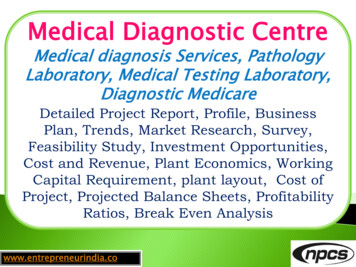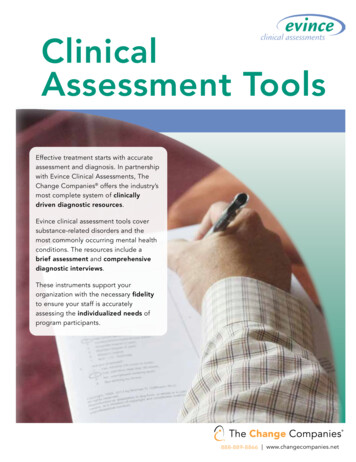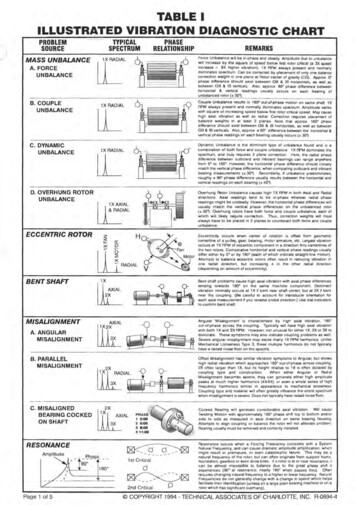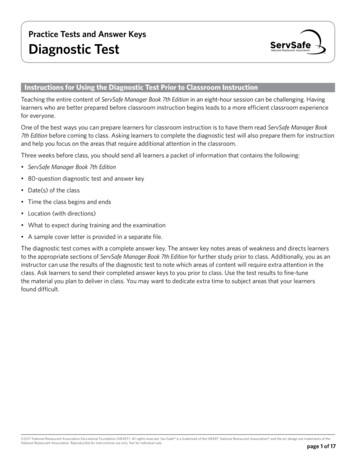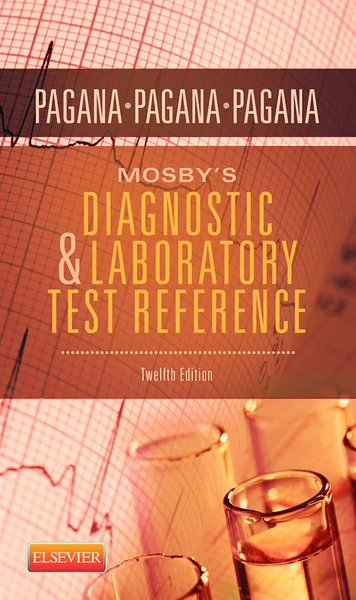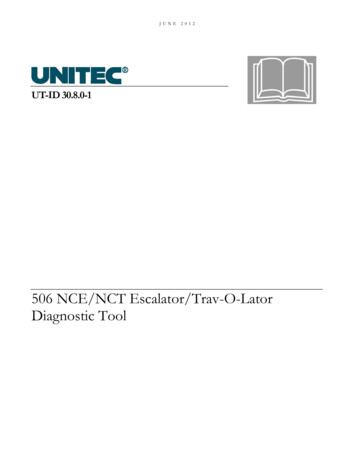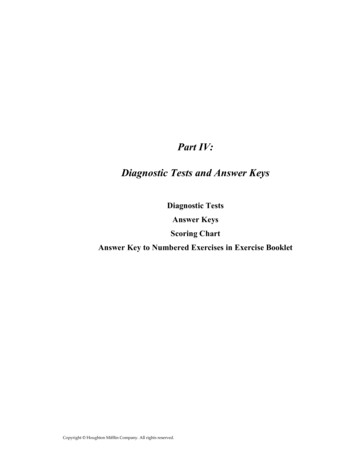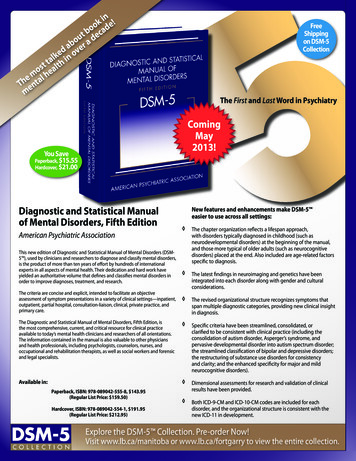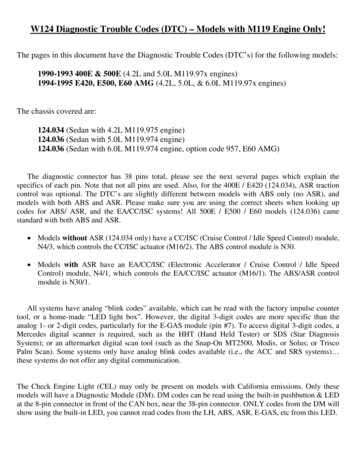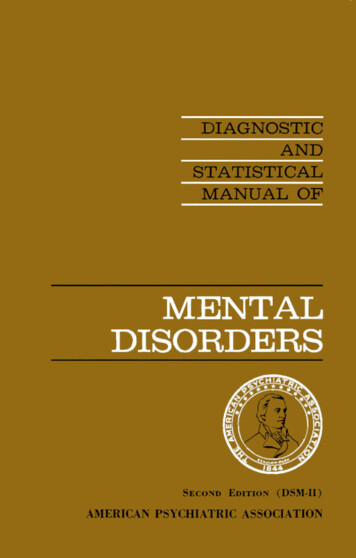
Transcription
DSM-IIDIAGNOSTIC AND STATISTICALMANUALOFMENTALDISORDERS(Second Edition)Prepared byTHE COMMITTEE ON NOMENCLATURE AND STATISTICSOF THE AMERICAN PSYCHIATRIC ASSOCIATIONPublished byAMERICAN PSYCHIATRIC ASSOCIATION1700 18th Street, N. W.Washington, D. C. 200091968
Copyright 1968American Psychiatric Association1700 Eighteenth Street, N.W.Washington, D. C. 20009Library of Congress Catalogue Number: 68-26515This Manual may be ordered at 3.50 per copy from Publications Office,American Psychiatric Association, 1700 18th Street, N.W., Washington, D. C.,20009. There is a 10% discount for 10 copies or more, and 20% for 50 or more.Also, a special library bound edition is available at 5.00 per copy.
Committee on Nomenclature and Statistics, 1967ERNEST M. GRUENBERG, ChairmanRICHARD L. JENKINSLOTHAR B. KALINOWSKYHENRIETTE KLEINBENJAMIN PASAMANICKW. R. SLENGERMORTON KRAMER, ConsultantROBERT L. SPITZER, ConsultantLAWRENCE C. KOLB, Co-ordinating ChairmanEDWARD STAINBROOK, Representative of CouncilOther Members of the Committee, 1946-1963BALDWIN L. KEYES, 1947-1952LAWRENCE C. KOLB, 1947-1950and 1954-1960NOLAN D. C. LEWIS, 1946-1948Chairman, 1946-1948JAMES V. MAY, 1937-1948H. HOUSTON MERRITT, 1946-1948GEORGE N. RAINES, 1948-1959Chairman, 1948-1949and 1951-1954J. DAVIS REICHARD, 1946-1949MABEL Ross, 1951-1957ROBERT S. SCHWAB, 1949-1952GEORGE S. SPRAGUE, 1945-1948EDWARD A. STRECKER, 1948-1951HARVEY J. TOMPKINS, 1950-1955PAUL L. WHITE, 1946-1950FRANZ ALEXANDER, 1947-1949JOHN M. BAIRD, 1948-1951ABRAM E. BENNETT, 1941-1946GEORGE F. BREWSTER, 1946-1948HENRY BRILL, 1958-1965Chairman, 1960-1965NORMAN Q. BRILL, 1946-1948WALTER L. BRUETSCH, 1944-1949JOHN M. CALDWELL, 1948-1951J. P. S. CATHCART, 1941-1946SIDNEY G. CHALK, 1947-1950CLARENCE O CHENEY, 1942-1947NEIL A. DAYTON, 1936-1950JACOB H. FRIEDMAN, 1947-1949MOSES M. FROHLICH, 1948-1960Chairman, 1956-1960ERNEST S. GODDARD, 1950-1966JACOB KASANIN, 1944-1946111
ACKNOWLEDGEMENTThe undersigned, at the request of the President of theAmerican Psychiatric Association, served as consultantsto the APA Medical Director and approved the final formof this Manual before publication. Dr. Paul T. Wilson ofthe APA staff undertook extensive editorial revision of theoriginal manuscript and was notably successful in clarifyingand adding precision to the definitions of terms. He wasassisted by Mr. Robert L. Robinson. We are deeply gratefulto both.Bernard C. Glueck, M. D.ChairmanRobert L. Spitzer, M. D.Morton Kramer, Sc. D.
Click Table of Contents entries toreach corresponding book sections.TABLE OF CONTENTSForeword by Ernest M. Gruenberg, M. D., Dr. P. H.viiIntroduction: The Historical Background of ICD-8by Morton Kramer, Sc. DxiSection 1 The Use of This Manual: Special Instructions1Section 2 The Diagnostic Nomenclature: List of Mental Disordersand Their Code Numbers5Section 3 The Definitions of Terms14I. Mental Retardation14II. Organic Brain Syndromes22A. Psychoses Associated with Organic Brain Syndromes 24B. Non-psychotic Organic Brain Syndromes31III. Psychoses not Attributed to Physical ConditionsListed Previously32IV. Neuroses39V. Personality Disorders and Certain Other Non-psychoticMental Disorders .41VI. Psychophysiologic Disorders46VII. Special Symptoms47VIII. Transient Situational DistrubancesIX. Behavior Disorders of Childhood and AdolescenceX. Conditions Without Manifest Psychiatric Disorder andNon-specific ConditionsXI. Non-diagnostic Terms for Administrative Use48495152Section 4 Statistical Tabulations53Section 5 Comparative Listing of Titles and Codes64Section 6 Detailed List of Major Disease Categories in ICD-883V
This page intentionally left blank
FOREWORDErnest M. Gruenberg, M.D., Dr. P.H.Chairman, Committee on Nomenclature and StatisticsAmerican Psychiatric AssociationThis second edition of the Diagnostic and Statistical Manual of MentalDisorders (DSM-II) reflects the growth of the concept that the peopleof all nations live in one world. With the increasing success of theWorld Health Organization in promoting its uniform InternationalClassification of Diseases, already used in many countries, the timecame for psychiatrists of the United States to collaborate in preparingand using the new Eighth Revision of that classification (ICD-8) as approved by the WHO in 1966, to become effective in 1968. The rapidintegration of psychiatry with the rest of medicine also helped create aneed to have psychiatric nomenclature and classifications closely integrated with those of other medical practitioners. In the United Statessuch classification has for some years followed closely the InternationalClassification of Diseases.With this objective in view, the Council of the American PsychiatricAssociation authorized its APA Committee on Nomenclature and Statistics to work closely with the Subcommittee on Classification of MentalDisorders of the U. S. National Committee on Vital and Health Statistics. The latter committee is advisory to the Surgeon General of thePublic Health Service and was entrusted with responsibility for developing U. S. revision proposals for ICD-8, including the Section on MentalDisorders. Dr. Henry Brill, who was chairman of the APA Committeefrom 1960-1965, served as a member of the U. S. Subcommittee onClassification of Mental Disorders.Dr. Brill also, it should be noted, served as Temporary Adviser tothe Subcommittee on the Classification of Diseases of the ExpertCommittee on Health Statistics of the World Health Organization whichmade the final recommendations on the form and content of the varioussections of the ICD. The final version of ICD-8 was adopted unanimously by the Nineteenth World Health Assembly in May, 1966, tobecome effective in all member states in 1968. Thus, from the beginningthe United States representatives helped to formulate the Section onMental Disorders in ICD-8 on which this Manual is based.The WHO Nomenclature Regulations governing the use of the ICDrecognizes that countries may, under exceptional circumstances, modifyvii
MENTAL DISORDERSinclusions within a major diagnostic category, provided the basic content of that category is not changed. In preparing this Manual theCommittee had to make adjustments within a few of the ICD categoriesto make them conform better to U.S. usage. Decisions were also maderegarding certain diagnoses which have not been generally accepted inU. S. psychiatry. Some of these diagnoses have been omitted here;others have been included and qualified as controversial. The diagnosesat issue are: Psychosis with childbirth, Involutional melancholia, andDepersonalization syndrome. Also this Manual suggests omitting certain specific categories and makes subdivisions in other categories,assigning unused numbers in ICD-8 to the new subcategories.In publishing the Manual the Association provides a service to thepsychiatrists of the United States and presents a nomenclature that isusable in mental hospitals, psychiatric clinics, and in office practice. Ithas, in fact, a wider usage because of the growth of psychiatric workin general hospitals, both on psychiatric wards and in consultationservices to the patients in other hospital departments, and in comprehensive community mental health centers. It will also be used inconsultations to courts and industrial health services.No list of diagnostic terms could be completely adequate for use inall those situations and in every country and for all time. Nor can itincorporate all the accumulated new knowledge of psychiatry at any onepoint in time. The Committee has attempted to put down what it judgesto be generally agreed upon by well-informed psychiatrists today.In selecting suitable diagnostic terms for each rubric, the Committeehas chosen terms which it thought would facilitate maximum communication within the profession and reduce confusion and ambiguity toa minimum. Rationalists may be prone to believe the old saying that"a rose by any other name would smell as sweet"; but psychiatristsknow full well that irrational factors belie its validity and that labels ofthemselves condition our perceptions. The Committee accepted thefact that different names for the same thing imply different attitudesand concepts. It has, however, tried to avoid terms which carry withthem implications regarding either the nature of a disorder or its causesand has been explicit about causal assumptions when they are integralto a diagnostic concept.In the case of diagnostic categories about which there is currentcontroversy concerning the disorder's nature or cause, the Committeehas attempted to select terms which it thought would least bind thejudgment of the user. The Committee itself included representativesVlll
FOREWORDof many views. It did not try to reconcile those views but rather tofind terms which could be used to label the disorders about which theywished to be able to debate. Inevitably some users of this Manual willread into it some general view of the nature of mental disorders. TheCommittee can only aver that such interpretations are, in fact,unjustified.Consider, for example, the mental disorder labeled in this Manual as"schizophrenia," which, in the first edition, was labeled "schizophrenicreaction." The change of label has not changed the nature of the disorder, nor will it discourage continuing debate about its nature orcauses. Even if it had tried, the Committee could not establish agreement about what this disorder is; it could only agree on what to callit. In general, the terms arrived at by representatives of many countriesin the deliberations held under WHO auspices have been retained preferentially, unless they seemed to carry unacceptable implications orambiguities.The first edition of this Manual (1952) made an important contribution to U. S. and, indeed, world psychiatry. It was reprinted twentytimes through 1967 and distributed widely in the U. S. and othercountries. Until recently, no other country had provided itself with anequivalent official manual of approved diagnostic terms. DSM-I wasalso extensively, though not universally, used in the U. S. for statisticalcoding of psychiatric case records. In preparing this new edition, theCommittee has been particularly conscious of its usefulness in helpingto stabilize nomenclature in textbooks and professional literature.A draft of this Manual, DSM-II, was circulated to 120 psychiatristsin February 1967, with a request for specific suggestions to eliminateerrors and to improve the quality of the statements indicating theproper usage of terms which the Manual describes. Many extremelyvaluable replies were received. These were collated and studied by themembers of the Committee prior to its meeting in May 1967, at whichtime the Committee formulated the present manuscript and submittedit to the APA Executive Committee for approval. In December 1967the APA Council gave it final approval for publication.Throughout, the Committee has had the good fortune to have asconsultants Dr. Morton Kramer and Dr. Robert L. Spitzer. Dr. Kramer,Chief of the Biometry Branch of the National Institute of Mental Health,played a similarly vital role in the formulation of DSM-I. His intelligentand sustained concern with the problems encountered has assured thatIX
MENTAL DISORDERSthe preservation of statistical continuity has been considered at everystage in the development of this Manual. He is specifically responsiblefor the preparation of the Introduction following and Sections 4, and 5of this Manual. Dr. Robert L. Spitzer, Director, Evaluation Unit,Biometrics Research, New York State Psychiatric Institute, served asTechnical Consultant to the Committee and contributed importantlyto the articulation of Committee consensus as it proceeded from onedraft formulation to the next.The present members of the Committee on Nomenclature andStatistics owe a deep debt to former chairmen and members of theCommittee who provided the foundation upon which the second editionwas prepared. In the Foreword to DSM-I will be found an extensivedescription of those who contributed to the first edition. Because thissecond edition is, in fact, the product of the continuing endeavorsof the Committee's changing members, all members of the Committeesince 1946 are listed as authors.As Chairman since 1965, the writer wishes to express his personaldeep appreciation to the hard-working members of the Committee andits two consultants, all of whom participated vigorously and thoughtfullyin the Committee's deliberations and the formulation of the many draftrevisions that were required.New York, N.Y.March, 1968x
INTRODUCTION:THE HISTORICAL BACKGROUND OF ICD-8MORTON KRAMER, Sc.D.Chief, Biometry Branch, National Institute of Mental HealthThe Classification of Mental Disorders in the Sixth Revision of theInternational Classification of Diseases (ICD-6) was quite unsatisfactory for classifying many of the diagnostic terms that were introducedin the first edition of this manual (DSM-I, 1952). For example, withcertain exceptions, ICD-6 did not provide rubrics for coding chronicbrain syndromes (associated with various diseases or conditions) withneurotic or behavioral reactions or without qualifying phrases, nor didit provide for the transient situational personality disorders. The exceptions were post-encephalitic personality and character disordersamong the chronic brain syndromes, alcoholic delirium among theacute brain syndromes, and gross stress reaction among the transientdisorders.Accordingly, in 1951, the U. S. Public Health Service established aworking party comprising the late Dr. George Raines, representing theAmerican Psychiatric Association, and three others from the PublicHealth Service, Dr. Selwyn Collins, Mrs. Louise Bollo, and the author,to develop a series of categories for mental disorders that could beintroduced into appropriate places in ICD-6 to adapt it for use in theUnited States.1The shortcomings of ICD-6 (and of a seventh edition in 1955 whichdid not revise the section on mental disorders), pointed up the unsuitability of its use in the United States for compiling statistics on thediagnostic characteristics of patients with mental disorders or for indexingmedical records in psychiatric treatment facilities. Moreover, thesection on mental disorders was not self-contained. Certain mentadisorders occurred in other sections of the ICD. General paralysiswas classified under syphilis, and post-encephalitic psychosis under thelate effects of acute infectious encephalitis, for example. Also, many olthe psychoses associated with organic factors were grouped in a catch-alcategory of psychoses with other demonstrable etiology.1See Appendix A, DSM-I. It reveals the extensive adjustments that had to b introduced into ICD-6 to make it usable in the U. S. for coding the diagnostuterms contained in DSM-I.XI
MENTAL DISORDERSThe United States, however, was not the only country which foundthe section on mental disorders in ICD-6 unsatisfactory. In 1959, Professor E. Stengel, under the auspices of the World Health Organization,published a study revealing general dissatisfaction in all WHO membercountries.1 This finding, combined with the growing recognition ofmental disorders as a major international health concern, led WHO tourge its member states to collaborate in developing a classification ofthese disorders that would overcome the ICD's shortcomings and gaingeneral international acceptance. Such a classification was recognizedas indispensable for international communication and data collection.To initiate the work of revising the ICD, the U. S. Public HealthService then established a series of subcommittees of its NationalCommittee on Vital and Health Statistics, including a Subcommittee onClassification of Mental Disorders. The National Committee is advisoryto the Surgeon General on technical matters and developments in thefield of vital and health statistics. The goal of all subcommittees wasto complete their recommendations in time for consideration by theInternational Revision Conference, which WHO had scheduled forJuly 1965.The Subcommittee on Classification of Mental Disorders, appointedby the National Committee on Vital and Health Statistics, comprisedDr. Benjamin Pasamanick, Chairman, Dr. Moses M. Frohlich (thenchairman of the APA Committee on Nomenclature and Statistics),Dr. Joseph Zubin, and the author. Later, Dr. Henry Brill was madeChairman of the APA Committee and replaced Dr. Frohlich on theSubcommittee. Dr. Leon Eisenberg, a child psychiatrist, was alsoadded to the Subcommittee.Throughout, the Subcommittee worked very closely with Dr. Brill inthe latter's capacity as chairman of the APA Committee, and he activelyparticipated in developing the Draft Classification that was submittedby the U. S. to the first meeting of the Subcommittee on Classificationof Diseases of the WHO Expert Committee on Health Statistics inGeneva, Switzerland in November 1961. Dr. Brill was present at themeeting as an adviser.Following this meeting, the possibility and desirability occurred tothe U. S. Subcommittee of working with colleagues in the UnitedKingdom to develop and agree upon a single classification of mental1Stengel, E. (1960), "Classification of Mental Diseases", Bull, of Wld. Hlth.Org., 21, 601Xll
INTRODUCTIONdisorders. The counterpart committee in the U. K. readily agreed, and ajoint meeting with them was held in September 1962. Again, Dr. Brillplayed a most constructive role in achieving agreement on a singleclassification.By April of 1963 it was possible to report this achievement to mentalhealth and hospital authorities in the United States and to solicit theircomments on the U. S.-U. K. draft which were uniformly constructiveand for the most part favorable.Thus reinforced, the joint U. S.-U. K. proposal for a classificationof mental disorders was submitted to WHO in midsummer of 1963.By this time, WHO had received seven other proposals, from Australia,Czechoslovakia, the Federal Republic of Germany, France, Norway,Poland, and the Soviet Union. WHO called a meeting in Geneva inSeptember 1963 to attempt the formulation of a single proposal. Dr.Benjamin Pasamanick and the author came from the U. S. to attend themeeting, which was attended by several European psychiatrists. It wasquite gratifying that the meeting elicited very considerable agreementon the classification of schizophrenia; paranoid states; the psychosesassociated with infections, organic, and physical conditions; nonpsychotic conditions associated with infections, organic, and physicalconditions; mental retardation; physical disorders of presumablypsychogenic origin; special symptom reactions; addictions; and transient situational disturbances. The areas that still remained in disagreement were the affective disorders, neurotic depressive reaction,several of the personality disorders (paranoid, antisocial reaction, andsexual deviation), and mental retardation with psychosocial deprivation.Although all differences still were not resolved, the general arrangementand content of the classification that resulted from this meeting werein accord with the U. S.-U. K. proposal.The WHO Expert Subcommittee on Classification of Diseases thenmet in October and November 1963 to consider the results of theSeptember meeting. At this point, the U. S. submitted a revised proposal.It had become quite clear by now, for example, that there would belittle support for the U. S. terminology "Brain syndrome associated with(a specific organic or physical disorder) with psychotic reaction."Nevertheless, the classification of organic psychoses proposed by theU. S. and the U. K. was acceptable to others if the phrase "Brainsyndrome" was dropped. The term "non-psychotic conditions associatedxiii
MENTAL DISORDERSwith organic or physical conditions" was acceptable, whereas "Brainsyndrome with organic or physical condition" was not. Accordingly,some modifications of this order were proposed.Two psychiatrists who acted as advisers at this Expert Committeemeeting were Dr. Henry Brill for the U. S. and Professor A. V.Snezhnevsky, Director of the Institute of Psychiatry of the Academy ofMedical Sciences, for the U.S.S.R. They were invited to resolve somecontroversial issues centering around three proposed diagnoses: antisocial personality, reactive psychosis, and mental retardation withpsycho-social deprivation.The report of this meeting and the proposed classification that resultedfrom it were then submitted to the Expert Committee on Health Statistics which met in Geneva in October 1964. Based on the report of thismeeting and further evaluation of specific needs within differentcountries, the Secretariat of WHO drafted a final revision proposalwhich included rubrics for the diagnoses antisocial personality, mentalretardation with psychosocial deprivation, and a separate category forthe various reactive psychoses. This draft was submitted to and approved unanimously by the International Revision Conference in July1965. The recommendations of this conference were approved unanimously by the 19th World Health Assembly in May 1966.Shortly after the International Revision Conference, Dr. ErnestGruenberg, who became Chairman of the APA Committee on Nomenclature and Statistics in 1965, prepared a special supplement for theeighteenth printing of DSM-I (November 1965) in which he describedthe plan for revision and reproduced the section on mental disorders ofthe International Classification of Diseases as approved by the Conference.There is yet another important action to be cited. The WHO ExpertSubcommittee on Classification of Diseases, at its first meeting inNovember 1961, recommended that WHO establish for internationaluse a glossary of operational definitions of the terms that would beincluded hi the revised classification ICD-8. This was viewed as anessential step in solving practical problems related to the classificationof those disorders for international purposes. Two years later, inNovember 1963, the same committee further underscored its concernby urging all participating countries to develop national glossaries asxiv
INTRODUCTIONa first step toward achieving a single international glossary. Operationaldefinitions applicable in the U. S. appear in Section 3 in this Manual.The United Kingdom has also prepared a set of operational definitions1and several other countries have them in progress. The WHO hasinitiated plans to develop the international glossary.In sum, the classification of mental disorders in ICD-8 on which thisManual is based is clearly the product of an international collaborativeeffort that started in 1957 and culminated in the International RevisionConference of July 1965.The U. S. recommendations presented by Dr. Henry Brill in Genevahad considerable impact on the form and content of the final classification. Those recommendations included the incorporation into the ICDof a single section providing a comprehensive classification of mentaldisorders and one that relates mental disorders associated with organicand physical factors to other disease categories in the ICD. Also, aseries of categories that did not appear in ICD-6 were added, namely,mental disorders not specified as psychotic associated with organic andphysical disorders, physical disorders of presumably psychogenic origin,and transient situational disturbances. Finally, a much more completeclassification of mental retardation, based on recommendations of theAmerican Association on Mental Deficiency, was accepted.The new classification may be considered an achievement of the firstorder in international professional collaboration. It takes into accountestablished knowledge of etiology, and where such knowledge is notavailable, it attempts to provide a middle ground to satisfy the needsof psychiatrists of different schools of theoretical orientation. It alsois, manifestly, a compromise which will fully satisfy psychiatrists neitherin the U. S. nor in any other country. The WHO is fully aware of thisand already has programs under way looking to a still more satisfactoryclassification in the ninth revision.2 The achievement of ICD-8 and theexperience underlying it augurs well for ICD-9.1A Glossary of Mental Disorders, (1968), Prepared by the Subcommittee onClassification of Mental Disorders of the Register General's Advisory Committee on Medical Nomenclature and Statistics. General Register Office, Studieson Medical and Population Subjects No. 22, Her Majesty's Stationery Office,London2Lin, T., (1967), "The Epidemiological Study of Mental Disorders by WHO", Soc.Psychiat. 1, 204xv
This page intentionally left blank
Section1THE USE OF THIS MANUAL: SPECIALINSTRUCTIONSAbbreviations and Special SymbolsThe following abbreviations and special symbols are used throughoutthis Manual:WHO—The World Health OrganizationICD-8 —The International Classification of Diseases, Eighth Revision, World Health Organization, 1968. For use in theUnited States see: Eighth Revision International Classification of Diseases Adapted for Use in the United States,Public Health Service Publication No. 1693, U. S. Government Printing Office, Washington, D. C. 20402.DSM-I —Diagnostic and Statistical Manual, Mental Disorders,American Psychiatric Association, Washington, D. C.,1952 (out of print).DSM-II —This Manual: Diagnostic and Statistical Manual of MentalDisorders, Second Edition, American Psychiatric Association, Washington, D. C., 1968.[ ]—The brackets indicate ICD-8 categories to be avoided inthe United States or used by record librarians only.*(( ) )OBS—Asterisk indicates categories added to ICD-8 for use inthe United States only.—Double parentheses indicate ICD-8 terms equivalent toU. S. terms.—Organic Brain Syndrome(s), i.e. mental disorders causedby or associated with impairment of brain tissue function.The Organization of the Diagnostic NomenclatureWhile this Manual generally uses the same diagnostic code numbersas ICD-8, two groups of disorders are out of sequence: Mental retardation and the Non-psychotic organic brain syndromes. Mentalretardation is placed first to emphasize that it is to be diagnosed whenever present, even if due to some other disorder. The Non-psychotic or1
2MENTAL DISORDERSganic brain syndromes are grouped with the other organic brain syndromes in keeping with psychiatric thinking in this country, whichviews the organic brain syndromes, whether psychotic or not, as onegroup. Furthermore, the diagnostic nomenclature is divided into tenmajor subdivisions, indicated with Roman numerals, to emphasizethe way mental disorders are often grouped in the United States.The Recording of DiagnosesEvery attempt has been made to express the diagnoses in theclearest and simplest terms possible within the framework of modernusage. Clinicians will significantly improve communication and research by recording their diagnoses in the same terms.Multiple Psychiatric DiagnosesIndividuals may have more than one mental disorder. For example, apatient with anxiety neurosis may also develop morphine addiction. InDSM-I, drug addiction was classified as a secondary diagnosis, but addiction to alcohol, for example, could not be diagnosed in the presence of a recognizable underlying disorder. This manual, by contrast,encourages the recording of the diagnosis of alcoholism separately evenwhen it begins as a symptomatic expression of another disorder. Likewise mental retardation is a separate diagnosis. For example, there arechildren whose disorders could be diagnosed as "Schizophrenia, childhood type" and "Mental retardation following major psychiatric disorder."The diagnostician, however, should not lose sight of the rule of parsimony and diagnose more conditions than are necessary to account forthe clinical picture. The opportunity to make multiple diagnoses doesnot lessen the physician's responsibility to make a careful differentialdiagnosis.Which of several diagnoses the physician places first is a matter of hisown judgment, but two principles may be helpful in making his decision:1. The condition which most urgently requires treatment should belisted first. For example, if a patient with simple schizophrenia waspresented to the diagnostician because of pathological alcohol intoxication, then the order of diagnoses would be first, Pathologicalintoxication, and second, Schizophrenia, simple type.2. When there is no issue of disposition or treatment priority, themore serious condition should be listed first.
SPECIAL INSTRUCTIONS3It is recommended that, in addition to recording multiple disorders inconformity with these principles, the diagnostician underscore the disorder on the patient's record that he considers the underlying one. Because these principles will not always be applied or used consistently,statistical systems should account for all significant diagnoses recordedin every case.Qualifying Phrases and AdjectivesThe ICD is based on a classification scheme which allots three digitsfor the designation of major disease categories and a fourth digit forthe specification of additional detail within each category. DSM-IIhas introduced a fifth digit for coding certain qualifying phrases thatmay be used to specify additional characteristics of mental disorders.This digit does not disturb the content of either the three- or four-digitcategories in the ICD section on mental disorders.These terms are as follows:(1.) In the brain syndromes a differentiation of acute and chronicconditions may be provided by .xl acute and .x2 chronic. This willhelp maintain continuity with DSM-I. These qualifying adjectives arerecommended only for mental disorders specified as associated withphysical conditions and are, of course, unnecessary in disorders seenonly in an acute or chronic form.Those who wish to continue the distinction made in DSM-I between"acute" and "chronic" organic brain syndromes must now add theseas qualifying terms. Note also that a recorded dia
DSM-II DIAGNOSTIC AND STATISTICAL MANUAL OF MENTAL DISORDERS (Second Edition) Prepared by THE COMMITTEE ON NOMENCLATURE AND STATISTICS OF THE AMERICAN PSYCHIATRIC ASSOCIATION Published by AMERICAN PSYCHIATRIC ASSOCIA
